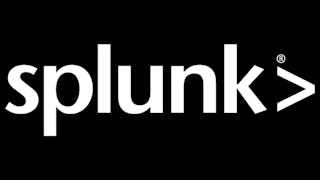This course provides a comprehensive understanding of Security Information and Event Management (SIEM) concepts and practical skills using Splunk as an SIEM solution. You will discover SIEM fundamentals, Splunk architecture, data collection and management, data analysis, and advanced topics such as correlation and incident response. By the end of the course, you will effectively apply Splunk for log analysis, threat detection, and security monitoring.
Learning Objectives: Module 1: Introduction to SIEM and Log Management • Recognize SIEM fundamentals and its role in cybersecurity. • Comprehend the importance of SIEM in security operations. • Discover benefits like improved threat detection and regulatory compliance. Module 2: Splunk Architecture and Installation • Make acquainted with Splunk as a leading SIEM platform. • Acquire hands-on experience with Splunk's features. • Evaluate Splunk's capabilities with other SIEM solutions. Module 3: Data Collection and Management in Splunk • Discover data ingestion, parsing, and indexing in Splunk. • Organize effective data inputs and organize data efficiently. • Identify data retention policies for optimal data management. Module 1: Introduction to SIEM and Log Management Description: In this module, you will understand the fundamentals of SIEM and its importance in modern cybersecurity. You can describe the core concepts of SIEM (Security Information and Event Management) and accentuate its significance in contemporary cybersecurity practices. You would be able to identify the critical role SIEM plays in security operations and incident response. You will learn the advantages that organizations can gain by implementing SIEM solutions, including improved threat detection, enhanced incident response, regulatory compliance, and operational efficiency. Module 2: Splunk Architecture and Installation Description: In this module, you will familiarize yourself with Splunk as a leading SIEM platform. Discover the extensive features and capabilities offered by Splunk, which positions it as a prominent SIEM solution. Explore Splunk's abilities in log management, data collection, and advanced analysis techniques. Gain hands-on experience with Splunk's user interface and basic functionality. Interact with the Splunk interface to develop a comprehensive understanding of its different components and navigation. You will inspect and discuss Splunk's log management, data collection, and advanced analysis techniques. Compare and contrast Splunk's abilities with other SIEM solutions in the market. Summarize the key benefits of using Splunk for log management and data analysis. Module 3: Data Collection and Management in Splunk Description: The "Data Collection and Management" module in Splunk focuses on the various methods and techniques for ingesting, organizing, and efficiently managing data within the Splunk platform. It reports data ingestion using forwarders, APIs, and other sources, as well as data parsing, indexing, and retention strategies to ensure data is accessible and usable for effective analysis and monitoring in Splunk. You will discover how to configure and manage data inputs effectively to ensure the timely and accurate ingestion of data into Splunk. Discover the concepts of fields, tags, and event types in Splunk for organizing and categorizing data efficiently. Recognize data retention policies and strategies to control the lifecycle of data in Splunk, ensuring relevant data is retained while managing storage costs. Target Learner: This course is designed for cybersecurity professionals, IT administrators, and analysts seeking to enhance their SIEM skills. It is also suitable for those interested in using Splunk for security monitoring and incident response. Learner Prerequisites: You should have basic knowledge of cybersecurity concepts and familiarity with IT systems and networks. No prior experience with Splunk or SIEM is required. Reference Files: You will have access to code files in the Resources section. Course Duration: 7 hours 20 minutes The course is designed to be completed in 3 weeks, including lectures, practical, and quizzes




















